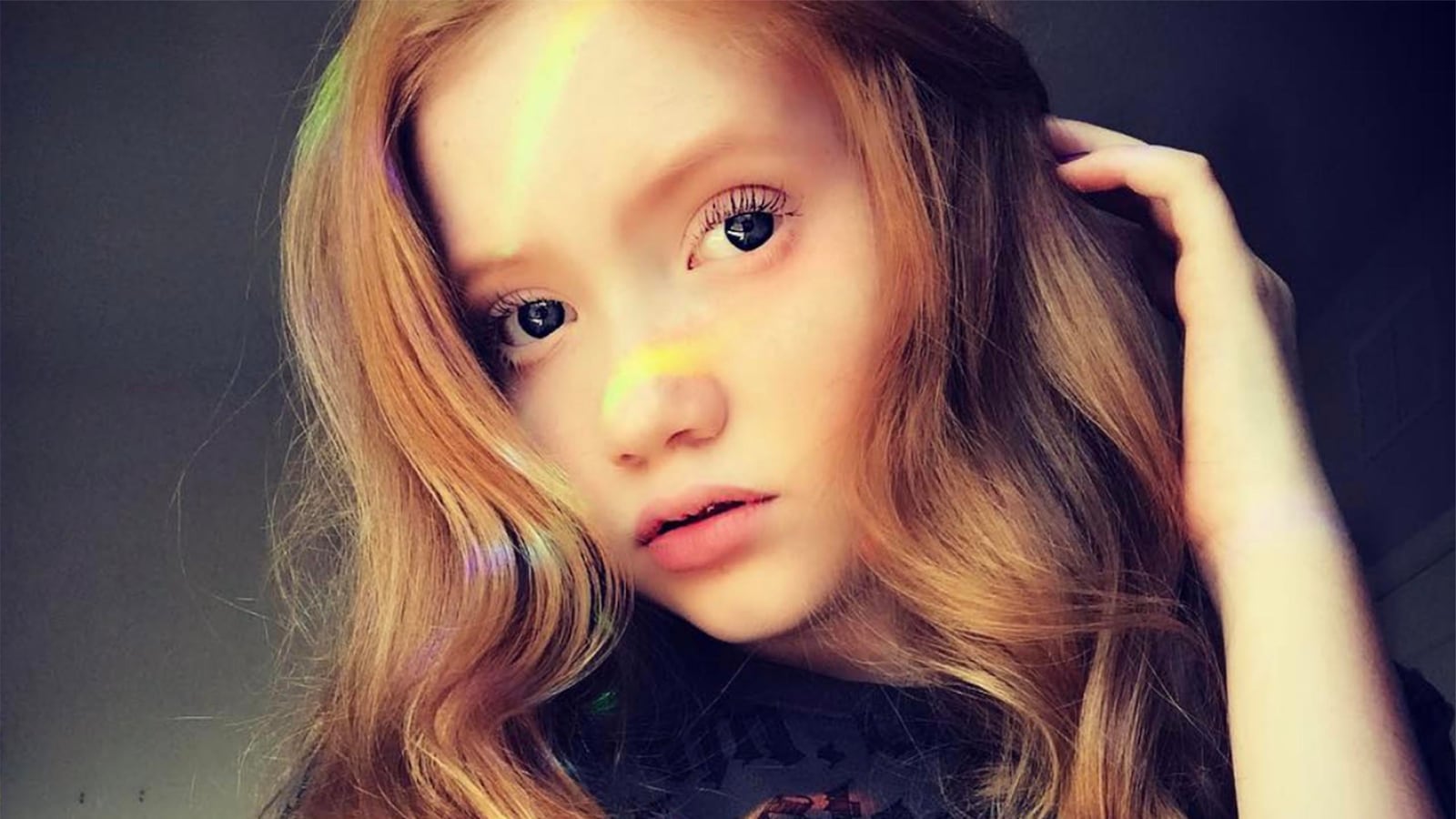In the video that would make her famous, Makenna Kelly sits in a bedroom next to a microphone the size of her head. The 13-year-old has braces, red hair, and speaks only in a whisper. For a minute, Makenna makes hushed small talk. Then, she unwraps a box of pure honeycomb and starts to eat it into the microphone, chewing with what can only be described as extremely sticky mouth sounds. She named the video “ASMR~ Eating Raw Honeycomb │EXTREMELY Sticky Mouth Sounds! 🍯.” It got 11.5 million views.
Before she uploaded what she now just calls “the honeycomb video,” Makenna had 656 subscribers on YouTube. Days later, she had almost 600,000. In the five months since, Makenna has become a household name on YouTube. Her other videos range between 500,000 and several million views. Last week, her channel “Life with MaK” hit the million-subscriber mark.
Makenna is what she calls an “ASMR-tist,” or a member of the very popular, very quiet part of YouTube where people eat, brush, and lightly tap stuff – stuff which can range from standard household goods to extremely niche ephemera, like, say, a collection of Titanic-themed books, trinkets, and documents – in order to trigger a sensation called “Autonomous Sensory Meridian Response,” or “ASMR.” Not everyone can experience ASMR, and there is no precise language to describe what, exactly, it feels like. Proponents compare it to a euphoric “brain tingle,” and science hasn’t gotten much more specific: one study called it a “flow-like” state.
At this point, it’s safe to say that that many people who spend a lot of time on the internet are familiar with ASMR—it’s been written about in major publications from Smithsonian to the New York Times, it inspired a web series of whispered celebrity interviews, and it has garnered enough interest on YouTube that many popular accounts have corporate sponsorships, and audiences in the hundred-thousands. But the phenomenon, which fans hail as a kind of relaxation or sleep therapy, hasn’t quite broken into the mainstream—certainly not the medical mainstream—remaining, instead, its own quiet corner in the arena of YouTube.
Makenna is that corner’s newest star. But she’s also something of an outlier, an unusual figure in a world of unusual figures. Makenna is really young—the kind of young where she says things like, “I want to be a teacher, an actress, or a dermatologist—not all three, but I haven’t chosen which one yet”; where she appends her birth year to usernames, a constant reminder that The Incredibles and Livestrong bracelets are both, impossibly, older than her; where she had to slow down her uploads in August, because the school year had started. The eighth-grader, in other words, has been around just barely longer than ASMR itself, and her earnest embrace of the practice reopens some of the questions that have dogged it since it began.
In late September, for example, Makenna uploaded a video called “ASMR~ 👮♀️🚓 SASSY Police Officer / Cop.” The seven-minute sketch opens on Mak in the driver’s seat of a sedan, pretending to be an officer who has just pulled someone over. In the opening shot, she straightens her mirrored aviators, whips out an iPhone, and dials up an imaginary partner. “Hey Jim,” she whispers. “It’s Queen Mak. We’ve got a live one.”
The skit has a silly and familiar quality, like the goofy plays kids might perform for their parents, only updated for the digital age. (As Makenna tells “Jim,” the “code” for their assignment, she visibly struggles not to laugh: “The code is R-as-in-rainbow-W-W-W-wing-wong-wang-O-O-orangutan-orange. Check back later. Okay. Bye!”) It’s also a textbook example of a common variety of ASMR video: role-play. In role-play videos—which are pretty much what they sound like—ASMR-tists take on familiar occupations and perform a short, usually whispered, scene for their viewers.
Makenna has made several of these—mostly “sassy” role plays, which she says her subscribers tend to favor, where she insults the viewer or ignores them, with an air of teenage disdain she’s too young to have yet herself. She’s played a range of professions, including sassy flight attendant, sassy waitress, sassy librarian, sassy dentist, and sassy Zumiez cashier, and for all of them, Makenna wears elaborate costumes. In the flight attendant video, she has a neck scarf and a navy jacket, embroidered with an airplane. In the dentist role play, she has latex gloves, a face mask, and one of those round little mirrors hygienists use to look at your gums. In the Zumiez clip, she wears a white Thrasher T-shirt and a name tag that reads “Kylie.”
The police video is no different. In it, Makenna wears a metallic blue dress, mirrored aviators, handcuff earrings, and thigh-high boots—a full cop costume, like something from a Halloween store. But when she uploaded a picture of her outfit to Instagram, the image elicited outrage, alarm and uneasiness from her followers. Comments poured in by the thousands.“This makes me really uncomfortable,” a user named 150belxiii wrote. Someone else joked: “*6in9ine and Drake joined the chat.*” A poster named _jamesqueen_ put a finer point on it: “This is extremely sexual.”
Though some thought the photo crossed a line, there was not exactly consensus. Hundreds rose to her defense. “To everyone saying it’s inappropriate. She just put on a costume,” wrote Daga.kohler. “Just because you think it’s inappropriate doesn’t mean it is.” Another countered that costumes are a standard part of ASMR role-play. The dissenters argued that alarmed viewers were projecting sexual content onto an otherwise innocent practice.
What emerged was a long, very comment-section conflict, filled with half-baked arguments and name-calling. It got so negative, Makenna intervened to end it (the 13-year-old tells people her nickname, “Mak,” also stands for her life philosophy: Meaning, Acceptance, Kindness). But at the crux of the tension was a concern: was this exploitative? Was there something unsettling about child-led ASMR? In the words of more than one follower: was this weird?
The unassailable weirdness of ASMR is hard to glide past. Weirdness, if anything, is the phenomenon’s most conspicuous quality, and has been since it first arose in 2007. In October of that year, a user named okaywhatever51838 started a new forum thread on the website SteadyHealth.com called “Weird sensation feels good.”
“[I] get this sensation sometimes. it just happenes randomly [sic],” they wrote. The “weird” feeling had been happening since the user was a kid and could come on randomly, from a range of triggers: watching a puppet show, being read to, having a classmate do them a favor, having a friend draw on the palm of their hand with markers. Others soon chimed in to agree.
“This happens to me too. I’ve never been able to find a name for it....” clawsofguthix68902 wrote, “It is really weird, but VERY enjoyable.” In a later post, the same user pleaded: “PLEASE, if ANYONE knows any information on this thing, pleaseeee reply. For the time being I’m going to call it WHS meaning Weird Head Sensation, haha :-).”
The weirdness, it seems, stems from confusion. No one understands what exactly ASMR is, and those that believe they do are put in the impossible position of having to explain a sensation others don’t experience. The cocktail of an elusive physical euphoria and highly particularized videos intended to “trigger it” is somehow both hilarious and creepy, and so it’s almost not surprising at all that, after okaywhatever51838 first described the sensation, it was quickly compared to arousal.
“The only way I can discribe [sic] it is like a silvery sparkle through my head and brain,” user bean487 wrote, “almost like a sort of head orgasm, but there is nothing sexual about it.” Later, someone writing under the handle “tingler” gave the nascent phenomenon a name: Attention Induced Head Orgasm.
The conflation of arousal and ASMR is now widespread, so much so that it has become something of a problem for its practitioners. Last year, ASMR YouTubers complained en masse that the platform was demonetizing their videos, flagging them as “not advertiser friendly,” and removing them from search results. ASMR-tists took another hit this summer, when China’s anti-porn task force banned the practice from all of its streaming platforms, noting that the agency needed to “thoroughly clean up vulgar and pornographic ASMR content.” And just last month, several prominent ASMR producers reported that their Paypal accounts—a common means for fans to compensate their favorite performers—had been permanently suspended. The ASMR-tists believed the gesture was rooted in the assumption that their transactions were sex-related. (In a statement published by Engadget, Paypal denied having an ASMR-specific policy, though they do have restrictions against “sexually oriented materials or services”).
To concede the similarity seems louche, but the areas of overlap are not exactly subtle. For one, there are actually erotic ASMR videos—a whole strain of porn is dedicated to so-called “eraudica.” But even those that aren’t explicitly sexual can bear a formal resemblance to pornography—one of the most common ASMR role plays, for example, is the doctor-patient scenario, a popular format in adult films. And an early article on ASMR, published in the popular German newspaper Süddeutsche Zeitung, observed that the comparison extends to even the pattern in which videos are consumed. Frequent watchers often return to “favorite” videos, but because ASMR triggers are habituating and lose their effect over time, users perpetually need to seek out new sources of stimulation. It doesn’t hurt that most ASMR-tists are good-looking girls.
The presumed overlap between ASMR and arousal is, at its core, what set people on edge about the rise of the community’s child star. But ASMR experts have always maintained that it’s an unsexual phenomenon, and have gone lengths to distance it from arousal, drawing comparisons instead to other nonerotic exercises, like massage, or anti-anxiety therapies and treatments.
When the “weird sensation” was eventually named in 2010, for example, ASMR blogger Jennifer Allen dubbed it “Autonomous Sensory Meridian Response” in order to align the phenomenon with clinical, rather than sexual language. And Craig Richard, a physiologist at Shenandoah University, who has led the charge into the murky terrain of ASMR research with his website, ASMR University, says that few people who watch the videos seek out the experience for arousal. A 2015 study found that, out of 475 participants, while 98 percent said they watched ASMR to relax, 82 percent said it helped them fall asleep, and 70 percent said they used it for stress management, while only 5 percent reported sexual responses. Richard, who runs an informal survey through his website, says that his data shows similar results.
New research may also explain some of the confusion. A common hypothesis about ASMR is that the sensation stems from a release of oxytocin: the “trust” hormone, a staple talking point in any birds-and-bees-type discussion, but also present during all kinds of bonding-related interactions, like childbirth, hugging, or grooming in other mammals.
Although no studies have yet shown a connection between oxytocin and ASMR, a paper published last month in the journal Social Neuroscience discovered something that suggests a correlation between ASMR stimulation and intimacy. Richard and his team observed subjects while they were watching trigger videos, and while they weren’t. From the fMRI images of their subjects’ brains, the researchers found that ASMR did activate certain areas associated with emotional arousal, empathy, and reward pathways.
“Here’s the exciting summary,” Richard said. “It is exciting, but it’s almost anticlimactic. Those are the same brain areas that are activated when they do scans on people thinking about their loved ones. Or processing what they call ‘affiliated behaviors.’ These are the areas that light up when people show caring and attention to each other.”
The research affirmed what Richard, a 40-something professor with a voice straight out of the videos he studies, had long suspected about ASMR. Just months after he first discovered it, he came up with a theory about its appeal. The idea struck him while driving in his car, listening to a popular performer who posts videos to an account called “Gentle Whispering.”
“I was just thinking—it’s almost like she’s a parent who’s soothing an infant. In a way, I feel like a child who’s being cared for,” he told The Daily Beast. “Picture any parent and you’ll see all the typical triggers for an ASMR video: whispering, soft voice, slow movements, simulated light touch, or, in the real world, actual light touch—like when you play with someone’s hair—it’s not much different than when you lightly touch a baby to soothe it.”
The arrival of children into the world of ASMR, in other words, might register as odd, in part because it represents a bizarre inversion of the parent-child dynamic. Mak, though barely old enough to babysit, sees herself as a kind of caretaker. She wants her fans to relax, get to sleep, or just feel pretty good.
“Help me in my venture to spread positivity, beauty, and self love through individual creativity,” she wrote under one video, called “ASMR~Dollar Tree Haul,” where she touches quotidian items like Reese’s cups and hairspray for 20 uninterrupted minutes. “You are perfect just the way you are!”
Mak and her mother, a veterinary medical professional named Nichole Lacy, say that fans overreacted about the cop costume. It was designed for children ages four to 11, they wrote to her followers in an Instagram story. They meant it only as a joke. “Do not take this seriously! 👮♀️ 🚓,” the video notes read. “It was SO HARD to film and not laugh! 🤪😂❤️🌈🌼💄” But Lacy understands some of the pushback. “It’s the kind of thing people love to hate,” she said. “It is pretty weird.”







